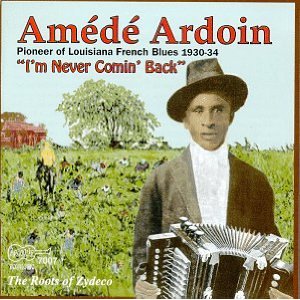O, moi je m'en vas, moi je m'en vas
Moi je m'en vas à la maison moi tout seul
Moi je m'en vas, moi j'après dire
Toi, ouais, tu fais, ô viens donc, me voir.
Pour ça tu me fais moi je m'en va
Moi, j'suis parti à puit d'huile, pour aller au bal,
Pour allerau bal, c'est voir, ô, ouais, les jolies femmes
C'est là-bas il faut tu vas.
O, c'est beau!
O, pour ça tu me fais moi je m'en vas, ouais, à puit d'huile,
Pour moi être capable aller me promener
Je vas au bal pour me voir des jolies femmes
O, c'est là-bas il faut tu vas pour t'amuser.
Toi, tu me fais, toi, ouais, catin,Moi, j'suis tout seul, mon je m'en vas à puit d'huile,Je vas jamais encore revenir pour moi,Je te voir, pour ça toi t'après me faire.
 |
| Amede Ardoin |
The first oil well in Louisiana was drilled in 1901 in a rice field on the "Mamou Prairie" in the community of Evangeline near Jennings. The owner of the property, Jules Clement, had noticed bubbles rising from a spot in one of his rice fields when it flooded. With the recent discovery in Spindle Top in mind, he conducted an experiment. He stood on an old stovepipe over the bubbles, lit a match and threw it into the pipe. Gas from the bubbles ignited.
By the 1930s, the industry had moved from south east Texas towards the Cajun prairies around near places Ardoin would perform. Ardoin's song (sometimes misspelled as "pétrolipères") reflected the socio-economic changes brought to south Louisiana by technological change, as people abandoned farming for more lucrative work in the oilfield. Amede Ardoin appears solo; his accordion being the lone accompaniment on his singularly complex rhythmic song.
Oh I'm going by myself, I'm going,
I am going to my house by myself,
I'm going, I tell you,
You, yeah, oh do come see me.
For what you've done, I will be by myself,
For me, I'm leaving the oil fields and going to the dance,
Going to the dance, to see, oh yeah, pretty women,
You must go there.
O, how beautiful!
Oh, for this is why i'm leaving, yeah, the oil field,
To be able to go for a walk,
I am going to the dance to see the pretty women,
Oh, you must go and have fun.You, you've made me this way, you, yeah, pretty doll,By myself, I'm all alone, I'm headed to the oil fields,I'll never come back,I'll show you, after all, you've done this.
 |
| Jennings Oil Field, 1912 |
- Cajun Breakdown : The Emergence of an American-Made Music By Ryan Andre Brasseaux
- http://musicrising.tulane.edu/discover/people/208/Amede
- http://www.redlick.com/review_read.php?id=92
- http://dnr.louisiana.gov/index.cfm?md=pagebuilder&tmp=home&pid=48
- Lyrics by Jerry M
Find:
I'm Never Comin Back: Roots of Zydeco (Arhoolie, 1995)
Cajun: Rare & Authentic (JSP, 2008)
Mama I'll Be Long Gone: The Complete Recordings of Amede Ardoin (Tompkins Square, 2011)

These songs would be forgotten if this wasn't done. Awesome work Wade
ReplyDelete